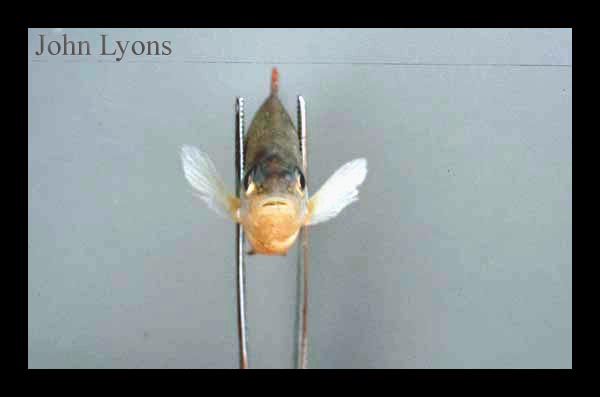
Adaptations
Lepomis humilis pictured above in natural habitat
According to the Wisconsin DNR, the Orange-spotted Sunfish is a very adaptable animal that can live in almost any freshwater environment. Very few people are ever able to see this fish due to the environment that it lives and thrives in. Orange spotted Sunfish are most adapted to the cloudy murky waters of rivers, which makes it a rare occurrence to see these bright color fish in the wild (WI DNR, 2001).
In Wisconsin most anglers, including myself, are on the look out for the bigger sportier fish like Muskie, Bass and Crappie. Knowing that, makes the tiny 4 inch Orange spotted Sunfish not a likely catch around the Wisconsin area. In most cases when an angler does run into an Lepomis humilis they are likely to believe it to be the baby version of a Pumpkin Seed Sunfish. Pumpkin Seed Sunfish are similar to the Orange spotted Sunfish due to the spotted patterns and the bright colors on their scales.
Lepomis humilis is the smallest of all the Centrarchidae. The average sunfish length is around 4 inches and can reach the record of 15 inches (MN DNR, 2011). Due to this, scientists believe that it makes the Lepomis humilis able to thrive in many more habitats, unlike the other bigger Centrarchidae around the United States (OH DNR, 2008).
Some characteristics that makes the Orange spotted Sunfish part of the Lepomis genus are; the 32 plus lined scales along its body, the dorsal fin usually has around 11 spikes, 3 spines on the anal fin, and a very large mouth for this small fish. The more noticeable characteristics would include its brightly colored body and orange spots. One thing this sunfish has that the other fish in it’s genus does not have are the sensory pores that are in the depressions near the eyes (AL DNR, 2008). Although these fish are rarely ever seen in the wild, they do have distinct coloration due to their surroundings. Depending on the climate, color, and river all of these Lepomis humilis can have distinct differences in their colorations.



